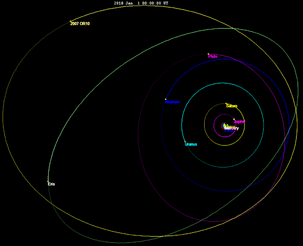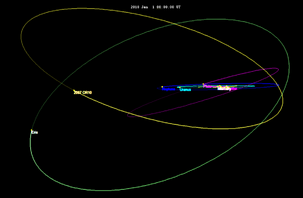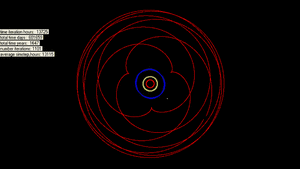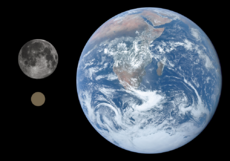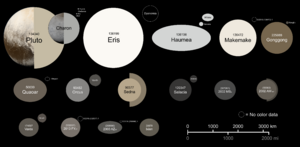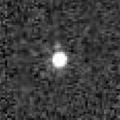225088 Gonggong facts for kids
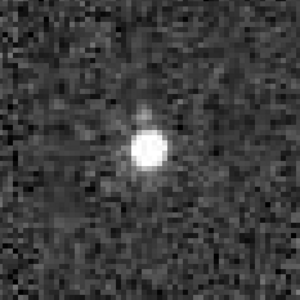
Low-resolution Hubble Space Telescope image of Gonggong and its moon Xiangliu, September 2010
|
|
| Discovery | |
|---|---|
| Discovered by |
|
| Discovery site | Palomar Obs. |
| Discovery date | 17 July 2007 |
| Designations | |
| MPC designation | (225088) Gonggong |
|
Named after
|
Gonggong |
| 2007 OR10 | |
| TNO · SDO 3:10 res. · dwarf planet |
|
| Orbital characteristics | |
| Epoch 17 December 2020 (JD 2459200.5) | |
| Uncertainty parameter 3 | |
| Observation arc | 37 years and 90 days (13604 days) |
| Earliest precovery date | 19 August 1985 |
| Aphelion | 101.190 AU (15.1378 Tm) |
| Perihelion | 33.781 AU (5.0536 Tm) |
| 67.485 AU (10.0956 Tm) | |
| Eccentricity | 0.49943 |
| 554.37 yr (202,484 days) | |
| 106.496° | |
|
Mean motion
|
0° 0m 6.401s / day |
| Inclination | 30.6273° |
| 336.8573° | |
| 17 February 1857 | |
| 207.6675° | |
| Known satellites | 1 (Xiangliu) |
| Physical characteristics | |
|
Mean diameter
|
1230±50 km |
|
Mean radius
|
615±25 km |
| Flattening | 0.03 (for a rotation period of 22.4 h) 0.007 (for a rotation period of 44.81 h) |
| Mass | (1.75±0.07)×1021 kg |
|
Mean density
|
1.74±0.16 g/cm3 |
|
Equatorial surface gravity
|
≈ 0.18 m/s2 |
|
Equatorial escape velocity
|
≈ 0.62 km/s |
| 22.40±0.18 h or 44.81±0.37 h (ambiguous, but 22.4 h more likely) |
|
| 0.14±0.01 | |
| B−V=1.38±0.03 V−R=0.86±0.02 V−I=1.65±0.028 |
|
| 21.4 | |
| 2.34 · 2.0 1.8 · 1.6 (assumed) |
|
Gonggong (officially known as 225088 Gonggong) is a dwarf planet located far beyond Neptune. It is part of a region called the scattered disc. Gonggong has a very stretched-out and tilted orbit around the Sun. Its distance from the Sun changes a lot, from about 34 times the Earth-Sun distance to 101 times.
As of 2019, Gonggong was about 88 times farther from the Sun than Earth. This makes it one of the farthest known objects in our Solar System. Gonggong moves in a special way with Neptune. For every 10 times Neptune orbits the Sun, Gonggong orbits 3 times. This is called an orbital resonance.
American astronomers Megan Schwamb, Michael Brown, and David Rabinowitz discovered Gonggong in July 2007. They announced their discovery in January 2009.
Gonggong is about 1,230 kilometers (764 miles) wide. This is similar in size to Charon, which is Pluto's largest moon. Gonggong is the fifth-largest known object beyond Neptune. Scientists think it might be round because it's big enough to have its own gravity pull it into a sphere. This means it could be a dwarf planet.
Gonggong's surface is red. This color likely comes from special organic materials called tholins. There is also water ice on its surface. This suggests that water might have erupted from inside Gonggong long ago and then frozen. Gonggong spins slowly, taking about 22 hours to complete one rotation. This slow spin might be because of its moon, Xiangliu, which pulls on it with tidal forces.
Gonggong is named after Gònggōng, a Chinese water god. This god was known for causing floods and chaos. The discoverers chose the name in 2019 after holding an online poll where people could vote for their favorite name.
Contents
Discovering Gonggong
How Gonggong was Found

Megan Schwamb, Michael Brown, and David Rabinowitz found Gonggong on July 17, 2007. They were part of a project called the Palomar Distant Solar System Survey. This project used the Samuel Oschin telescope in California. They were looking for distant objects far from the Sun.
Schwamb found Gonggong by comparing images taken at different times. She used a technique that made objects appear to "blink" if they moved. Gonggong moved very slowly in the images, which showed it was far away. This discovery was an important part of Schwamb's doctoral thesis. At the time, she was a student of Michael Brown.
The discovery of Gonggong was officially announced on January 7, 2009. It was first called 2007 OR10. This name is a temporary code that tells us when it was found. Scientists have observed Gonggong many times since its discovery. They even found older images of it from 1985.
How Gonggong Got its Name
Gonggong is named after Gonggong, a water god from Chinese mythology. This god is often shown with a human head and a snake body. Gonggong was known for causing floods and tilting the Earth. He was often joined by his helper, Xiangliu, a nine-headed snake monster.
Before it got its official name, Gonggong was the largest known object in the Solar System without a name. Michael Brown first nicknamed it "Snow White." He thought it would be white and icy, like other objects in the Haumea family. He also had discovered seven other large objects, which he called the "seven dwarfs" (like Pluto, Eris, and Makemake). But Gonggong turned out to be very red, so the nickname didn't fit.
In 2019, the scientists who found Gonggong asked the public to help choose a name. They offered three choices: Gonggong (Chinese), Holle (German), and Vili (Norse). These names were chosen because they were linked to water, ice, snow, or the color red. These are all things related to Gonggong. Also, each name had a companion figure that could later be used to name Gonggong's moon.
Over 280,000 people voted, and Gonggong received 46 percent of the votes. On May 29, 2019, the team announced Gonggong as the winning name. The name was approved by the International Astronomical Union (IAU) and officially announced on February 5, 2020.
Gonggong's Journey Around the Sun

Gonggong travels around the Sun at an average distance of about 67.5 times the Earth-Sun distance. It takes 554 years to complete one full orbit. Gonggong's orbit is very tilted compared to the flat plane where most planets orbit. This tilt is about 30.7 degrees.
Its orbit is also very stretched out, which means its distance from the Sun changes a lot. At its farthest point from the Sun, called aphelion, Gonggong is about 101.2 AU away. At its closest point, called perihelion, it is about 33.7 AU away. Gonggong was last closest to the Sun in 1857. It is currently moving farther away and will reach its farthest point by the year 2134.
Gonggong's orbit is quite unusual compared to other large objects in our Solar System. Its 554-year orbit is one of the longest. Its tilted orbit (31 degrees) is second only to Eris. Its stretched-out orbit (0.50 eccentricity) is also very high.
Because of its distant and stretched-out orbit, Gonggong is classified as a scattered disc object. It also has a special 3:10 resonance with Neptune. This means that for every 10 times Neptune goes around the Sun, Gonggong goes around 3 times.
As of 2021, Gonggong is about 89 AU from the Sun and is moving away at 1.1 kilometers per second (2,460 miles per hour). It is one of the farthest known objects from the Sun. Gonggong has been farther from the Sun than Sedna since 2013. It will even pass Eris in distance by 2045.
How Bright is Gonggong?
Gonggong has an absolute magnitude (H) of 2.34. This number tells us how bright an object would appear if it were a certain distance away. This makes Gonggong the seventh-brightest object known beyond Neptune.
Because Gonggong is so far away (88 AU from the Sun), it appears very dim from Earth. Its apparent magnitude is only 21.5. This means it is too faint to be seen with the naked eye. Even though it's closer to the Sun than Eris, Gonggong looks dimmer because Eris reflects more sunlight.
What is Gonggong Made Of?
Surface and Materials
The surface of Gonggong reflects about 14% of the sunlight that hits it. This is called its albedo. Gonggong's surface is likely similar to another object called Quaoar. Both are red and show signs of water ice and possibly methane on their surfaces.
Scientists studied the light reflected from Gonggong's surface. They found strong signs of water ice. The presence of water ice suggests that in the past, water might have erupted from inside Gonggong. This process is called cryovolcanism. The water would have then frozen on the surface.
Gonggong is one of the reddest objects found beyond Neptune. This is surprising because objects with a lot of water ice are usually more neutral in color. Its red color might be due to methane on its surface. When sunlight and cosmic rays hit methane, they can create reddish organic materials called tholins. Later observations also found signs of methanol on its surface.
Gonggong is big enough to hold onto small amounts of methane, even when it gets closer to the Sun. It might also keep other gases like ammonia, carbon monoxide, and nitrogen. Most smaller objects beyond Neptune lose these gases over time.
In 2022, the James Webb Space Telescope (JWST) looked at Gonggong. It found a lot of ethane ice on its surface. It also found small amounts of carbon dioxide and other complex organic materials. Interestingly, the JWST did not find methane or methanol, which earlier studies had suggested.
Does Gonggong Have an Atmosphere?
Because of the tholins on its surface, Gonggong might have a very thin atmosphere of methane. Even though Gonggong sometimes gets warm enough for methane to evaporate, its large size might help it keep some of this gas.
Scientists think Gonggong might have had a thicker atmosphere and more cryovolcanic activity when it first formed. But over time, gases like nitrogen and carbon monoxide would have escaped into space. Less volatile gases, like methane, are more likely to remain in its thin atmosphere today.
How Big is Gonggong?
| Year | Diameter | Method | Refs |
|---|---|---|---|
| 2010 | 1,752 km | thermal | |
| 2011 | 1,200+300 −200 km |
best fit albedo | |
| 2012 | 1,280±210 km | thermal | |
| 2013 | 1,142+647 −467 km |
thermal | |
| 2013 | 1,290 km | radiometric | |
| 2016 | 1,535+75 −225 km |
thermal | |
| 2018 | 1,230±50 km | radiometric |
As of 2019, Gonggong is estimated to be about 1,230 kilometers (764 miles) wide. Scientists figure this out by measuring its mass and guessing its density. This size makes Gonggong the fifth-largest object beyond Neptune. It's about the same size as Pluto's moon, Charon.
The International Astronomical Union (IAU) decides which objects are officially dwarf planets. They haven't officially added Gonggong to the list yet. However, many astronomers believe Gonggong is large enough to be a dwarf planet. Michael Brown, one of its discoverers, thinks it must be a dwarf planet.
Scientists have used different methods to estimate Gonggong's size over the years. Early estimates were around 1,752 km (1,089 mi). In 2012, the Herschel Space Observatory measured it at 1,280 km (795 mi). In 2016, the Kepler spacecraft suggested it might be even larger, around 1,535 km (954 mi). This would have made it the third-largest object beyond Neptune.
However, newer measurements in 2018 revised Gonggong's size to 1,230 km (764 mi). This was based on its mass and density, which they figured out from its moon's orbit. With this updated size, Gonggong is back to being the fifth-largest object beyond Neptune.
Mass, Density, and How it Spins
By studying the orbit of its moon, scientists calculated Gonggong's mass to be about 1.75 quintillion kilograms. Its density is about 1.72 grams per cubic centimeter. This means it's a bit heavier and denser than Charon.
Gonggong is the fifth most massive object beyond Neptune. Because it's so large, massive, and dense, scientists expect Gonggong to be in hydrostatic equilibrium. This means its own gravity has pulled it into a nearly round shape, like a slightly flattened sphere, due to its spin.
Gonggong's rotation period was first measured in 2016 using the Kepler space telescope. It takes about 22.4 hours for Gonggong to spin once. This is quite slow compared to most other objects beyond Neptune, which usually spin in 6 to 12 hours. Scientists think the slower spin might be due to its moon, which pulls on it.
Gonggong's Moon: Xiangliu
After finding out that Gonggong spins unusually slowly, scientists thought it might have a moon. A moon's gravity can slow down a planet's rotation over time.
Scientists then looked at old images of Gonggong taken by the Hubble Space Telescope in 2010. They found a faint moon orbiting Gonggong! This discovery was announced in October 2016. The moon is about 100 kilometers (62 miles) wide and takes about 25 days to orbit Gonggong.
On February 5, 2020, the moon was officially named Xiangliu. This name comes from the nine-headed poisonous snake monster that was a companion to Gonggong in Chinese mythology. The moon was named at the same time Gonggong itself received its official name.
Visiting Gonggong
Scientists have calculated how long it would take to send a spacecraft to Gonggong. A mission to fly by Gonggong would take at least 20 years with today's rocket technology. If a spacecraft used Jupiter's gravity to speed up (a gravity assist), it could take just under 25 years. This would happen if it launched around 2030 or 2031. When the spacecraft arrived, Gonggong would be about 95 AU from the Sun.
Images for kids
-
Low-resolution Hubble Space Telescope image of Gonggong and its moon Xiangliu, September 2010
-
Gonggong was discovered using the Samuel Oschin telescope at Palomar Observatory.
-
Ecliptic view of the highly inclined orbits of Gonggong (yellow) and Eris (green).
-
Apparent motion of Gonggong through the constellation Aquarius (years 2000 to 2050).
See also
 In Spanish: (225088) Gonggong para niños
In Spanish: (225088) Gonggong para niños
- List of gravitationally rounded objects of the Solar System
- List of Solar System objects most distant from the Sun
- List of possible dwarf planets


